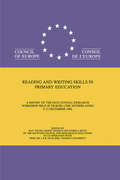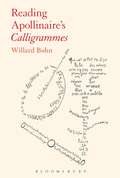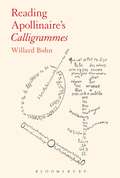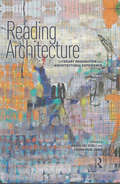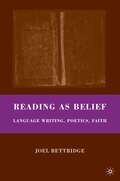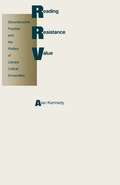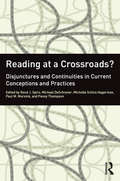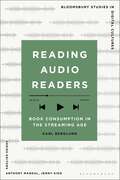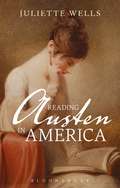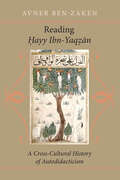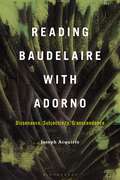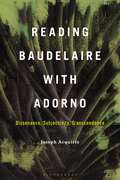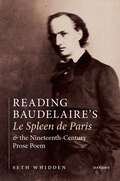- Table View
- List View
Reading And Writing Skills In Primary Education: A Report Of The Educational Research Workshop Held In Tilburg (the Netherlands) 9-12 December 1986
by May Young Marie Thomas Pamela MunnThis book summarizes aspects of reading and writing in primary schools, interest to educationists in the UK. It outlines the general process of reading comprehension into different levels.
Reading and Writing the Latin American Landscape
by B. Rivera-Barnes J. HoegSpanning the whole of Latin America, including Brazil, from its beginnings in 1492 up to the present time, Rivera-Barnes and Hoeg analyze the relationship between literature and the environment in both literary and testimonial texts, asking questions that contribute to the on-going dialogue between the arts and the sciences.
Reading Apollinaire's Calligrammes
by Willard BohnReading Apollinaire's Calligrammes examines Guillaume Apollinaire's second major collection of poetry. Composed between 1913 and 1918, the nineteen poems examined here fall into two main groups: the experimental poetry and the war poetry. They also provide glimpses of the poet's personal history, from his affair with Louise de Coligny-Châtillon to his engagement to Madeleine Pagès and his marriage with Jacqueline Kolb.Each section examines all of the previous scholarship for the work in question, provides a detailed analysis, and, in many cases, offers a new interpretation. Each poem is subjected to a meticulous line-by-line analysis in the light of current knowledge.
Reading Apollinaire's Calligrammes
by Willard BohnReading Apollinaire's Calligrammes examines Guillaume Apollinaire's second major collection of poetry. Composed between 1913 and 1918, the nineteen poems examined here fall into two main groups: the experimental poetry and the war poetry. They also provide glimpses of the poet's personal history, from his affair with Louise de Coligny-Châtillon to his engagement to Madeleine Pagès and his marriage with Jacqueline Kolb.Each section examines all of the previous scholarship for the work in question, provides a detailed analysis, and, in many cases, offers a new interpretation. Each poem is subjected to a meticulous line-by-line analysis in the light of current knowledge.
Reading Architecture: Literary Imagination and Architectural Experience
by Angeliki Sioli Yoonchun JungWhy write instead of draw when it comes to architecture? Why rely on literary pieces instead of architectural treatises and writings when it comes to the of study buildings and urban environments? Why rely on literary techniques and accounts instead of architectural practices and analysis when it comes to academic research and educational projects? Why trust authors and writers instead of sociologists or scientists when it comes to planning for the future of cities? This book builds on the existing interdisciplinary bibliography on architecture and literature, but prioritizes literature’s capacity to talk about the lived experience of place and the premise that literary language can often express the inexpressible. It sheds light on the importance of a literary instead of a pictorial imagination for architects and it looks into four contemporary architectural subjects through a wide variety of literary works. Drawing on novels that engage cities from around the world, the book reveals aspects of urban space to which other means of architectural representation are blind. Whether through novels that employ historical buildings or sites interpreted through specific literary methods, it suggests a range of methodologies for contemporary architectural academic research. By exploring the power of narrative language in conveying the experience of lived space, it discusses its potential for architectural design and pedagogy. Questioning the massive architectural production of today’s globalized capital-driven world, it turns to literature for ways to understand, resist or suggest alternative paths for architectural practice. Despite literature’s fictional character, the essays of this volume reveal true dimensions of and for places beyond their historical, social and political reality; dimensions of utmost importance for architects, urban planners, historians and theoreticians nowadays.
Reading Architecture: Literary Imagination and Architectural Experience
by Angeliki Sioli Yoonchun JungWhy write instead of draw when it comes to architecture? Why rely on literary pieces instead of architectural treatises and writings when it comes to the of study buildings and urban environments? Why rely on literary techniques and accounts instead of architectural practices and analysis when it comes to academic research and educational projects? Why trust authors and writers instead of sociologists or scientists when it comes to planning for the future of cities? This book builds on the existing interdisciplinary bibliography on architecture and literature, but prioritizes literature’s capacity to talk about the lived experience of place and the premise that literary language can often express the inexpressible. It sheds light on the importance of a literary instead of a pictorial imagination for architects and it looks into four contemporary architectural subjects through a wide variety of literary works. Drawing on novels that engage cities from around the world, the book reveals aspects of urban space to which other means of architectural representation are blind. Whether through novels that employ historical buildings or sites interpreted through specific literary methods, it suggests a range of methodologies for contemporary architectural academic research. By exploring the power of narrative language in conveying the experience of lived space, it discusses its potential for architectural design and pedagogy. Questioning the massive architectural production of today’s globalized capital-driven world, it turns to literature for ways to understand, resist or suggest alternative paths for architectural practice. Despite literature’s fictional character, the essays of this volume reveal true dimensions of and for places beyond their historical, social and political reality; dimensions of utmost importance for architects, urban planners, historians and theoreticians nowadays.
Reading as Belief: Language Writing, Poetics, Faith
by J. BettridgeReading as Belief advances the provocative idea that the disruptive techniques of recent innovative poetry require readers to become believers, occupying the same philosophical ground as the religious faithful. Pairing the poets Charles Bernstein and Bruce Andrews with John Calvin and Jonathan Edwards, and drawing on the work of diverse thinkers such as Wendy Brown, Ludwig Wittgenstein, Walter Benjamin, Stanley Cavell, William James, and Gilles Deleuze, this book demonstrates how belief, faith and language-attuned critical inquiry share an epistemology, one concerned with making meaning in the absence of certainty. Bettridge argues that recognizing such common ground helps overcome the cultural and philosophical impasse following the collapse of modernity s central narratives about language and liberal subjectivity.
Reading As Resistance And Value: Deconstructive Practice And The Politics Of Literary Critical
by Alan KennedyReading Asian American Literature: From Necessity to Extravagance
by Sau-ling Cynthia WongA recent explosion of publishing activity by a wide range of talented writers has placed Asian American literature in the limelight. As the field of Asian American literary studies gains increasing recognition, however, questions of misreading and appropriation inevitably arise. How is the growing body of Asian American works to be read? What holds them together to constitute a tradition? What distinguishes this tradition from the "mainstream" canon and other "minority" literatures? In the first comprehensive book on Asian American literature since Elaine Kim's ground-breaking 1982 volume, Sau-ling Wong addresses these issues and explores their implications for the multiculturalist agenda. Wong does so by establishing the "intertextuality" of Asian American literature through the study of four motifs--food and eating, the Doppelg,nger figure, mobility, and play--in their multiple sociohistorical contexts. Occurring across ethnic subgroup, gender, class, generational, and historical boundaries, these motifs resonate with each other in distinctly Asian American patterns that universalistic theories cannot uncover. Two rhetorical figures from Maxine Hong Kingston's The Woman Warrior, "Necessity" and "Extravagance," further unify this original, wide-ranging investigation. Authors studied include Carlos Bulosan, Frank Chin, Ashley Sheun Dunn, David Henry Hwang, Lonny Kaneko, Maxine Hong Kingston, Joy Kogawa, David Wong Louie, Darrell Lum, Wing Tek Lum, Toshio Mori, Bharati Mukherjee, Fae Myenne Ng, Bienvenido Santos, Monica Sone, Amy Tan, Yoshiko Uchida, Shawn Wong, Hisaye Yamamoto, and Wakako Yamauchi.
Reading Asian American Literature: From Necessity to Extravagance
by Sau-ling Cynthia WongA recent explosion of publishing activity by a wide range of talented writers has placed Asian American literature in the limelight. As the field of Asian American literary studies gains increasing recognition, however, questions of misreading and appropriation inevitably arise. How is the growing body of Asian American works to be read? What holds them together to constitute a tradition? What distinguishes this tradition from the "mainstream" canon and other "minority" literatures? In the first comprehensive book on Asian American literature since Elaine Kim's ground-breaking 1982 volume, Sau-ling Wong addresses these issues and explores their implications for the multiculturalist agenda. Wong does so by establishing the "intertextuality" of Asian American literature through the study of four motifs--food and eating, the Doppelg,nger figure, mobility, and play--in their multiple sociohistorical contexts. Occurring across ethnic subgroup, gender, class, generational, and historical boundaries, these motifs resonate with each other in distinctly Asian American patterns that universalistic theories cannot uncover. Two rhetorical figures from Maxine Hong Kingston's The Woman Warrior, "Necessity" and "Extravagance," further unify this original, wide-ranging investigation. Authors studied include Carlos Bulosan, Frank Chin, Ashley Sheun Dunn, David Henry Hwang, Lonny Kaneko, Maxine Hong Kingston, Joy Kogawa, David Wong Louie, Darrell Lum, Wing Tek Lum, Toshio Mori, Bharati Mukherjee, Fae Myenne Ng, Bienvenido Santos, Monica Sone, Amy Tan, Yoshiko Uchida, Shawn Wong, Hisaye Yamamoto, and Wakako Yamauchi.
Reading at a Crossroads?: Disjunctures and Continuities in Current Conceptions and Practices
by Penny Thompson Rand J. Spiro Michael DeSchryver Michelle Schira Hagerman Paul M. MorsinkThe Internet is transforming the experience of reading and learning-through-reading. Is this transformation effecting a radical change in reading processes as readers synthesize understandings from fragments across multiple texts? Or, conversely, is the Internet merely a new place to use the same reading skills and processes developed through experience with traditional print-based media? Are the changes in reading processes a matter of degree, or are they fundamentally new? And if so, how must reading theory, research, and instruction adjust? This volume brings together distinguished experts from the fields of reading research, teacher education, educational psychology, cognitive science, rhetoric and composition, digital humanities, and educational technology to address these questions. Every question is not answered in every chapter. How could they be? But every contributor has many thoughtful things to say about a subset of these important questions. Together, they add up to a comprehensive response to the issues the field faces as it approaches what may well be—or not —a crossroads. A website devoted to extending discussion around the book in creative (and disjunctive) ways [readingatacrossroads.net] moves it beyond the printed page.
Reading at a Crossroads?: Disjunctures and Continuities in Current Conceptions and Practices
by Penny Thompson Rand J. Spiro Michael DeSchryver Michelle Schira Hagerman Paul M. MorsinkThe Internet is transforming the experience of reading and learning-through-reading. Is this transformation effecting a radical change in reading processes as readers synthesize understandings from fragments across multiple texts? Or, conversely, is the Internet merely a new place to use the same reading skills and processes developed through experience with traditional print-based media? Are the changes in reading processes a matter of degree, or are they fundamentally new? And if so, how must reading theory, research, and instruction adjust? This volume brings together distinguished experts from the fields of reading research, teacher education, educational psychology, cognitive science, rhetoric and composition, digital humanities, and educational technology to address these questions. Every question is not answered in every chapter. How could they be? But every contributor has many thoughtful things to say about a subset of these important questions. Together, they add up to a comprehensive response to the issues the field faces as it approaches what may well be—or not —a crossroads. A website devoted to extending discussion around the book in creative (and disjunctive) ways [readingatacrossroads.net] moves it beyond the printed page.
Reading Audio Readers: Book Consumption in the Streaming Age (Bloomsbury Studies in Digital Cultures)
by Karl BerglundThe first computational study of reading to focus on audiobooks, this book uses a unique and substantial set of reader consumption data to show how audiobooks and digital streaming platforms affect our literary culture. Offering an academic perspective on the kind of user data hoard we associate with tech companies, it asks: when it comes to audiobooks, what do people really read, and how and when do they read it?Tracking hundreds of thousands of readers on the level per user and hour, Reading Audio Readers combines computational methods from cultural analytics with theoretical perspectives from book history, publishing studies, and media studies. In doing so, it provides new insights into reading practices in digital platforms, the effects of the audiobook boom, and the business-models for book publishing and distribution in the age of streamed audio.
Reading Audio Readers: Book Consumption in the Streaming Age (Bloomsbury Studies in Digital Cultures)
by Karl BerglundThe first computational study of reading to focus on audiobooks, this book uses a unique and substantial set of reader consumption data to show how audiobooks and digital streaming platforms affect our literary culture. Offering an academic perspective on the kind of user data hoard we associate with tech companies, it asks: when it comes to audiobooks, what do people really read, and how and when do they read it?Tracking hundreds of thousands of readers on the level per user and hour, Reading Audio Readers combines computational methods from cultural analytics with theoretical perspectives from book history, publishing studies, and media studies. In doing so, it provides new insights into reading practices in digital platforms, the effects of the audiobook boom, and the business-models for book publishing and distribution in the age of streamed audio.
Reading Austen in America
by Juliette WellsReading Austen in America presents a colorful, compelling account of how an appreciative audience for Austen's novels originated and developed in America, and how American readers contributed to the rise of Austen's international fame. Drawing on a range of sources that have never before come to light, Juliette Wells solves the long-standing bibliographical mystery of how and why the first Austen novel printed in America-the 1816 Philadelphia Emma-came to be. She reveals the responses of this book's varied readers and creates an extended portrait of one: Christian, Countess of Dalhousie, a Scotswoman living in British North America. Through original archival research, Wells establishes the significance to reception history of two transatlantic friendships: the first between ardent Austen enthusiasts in Boston and members of Austen's family in the nineteenth century, and the second between an Austen collector in Baltimore and an aspiring bibliographer in England in the twentieth.
Reading Austen in America
by Juliette WellsReading Austen in America presents a colorful, compelling account of how an appreciative audience for Austen's novels originated and developed in America, and how American readers contributed to the rise of Austen's international fame. Drawing on a range of sources that have never before come to light, Juliette Wells solves the long-standing bibliographical mystery of how and why the first Austen novel printed in America-the 1816 Philadelphia Emma-came to be. She reveals the responses of this book's varied readers and creates an extended portrait of one: Christian, Countess of Dalhousie, a Scotswoman living in British North America. Through original archival research, Wells establishes the significance to reception history of two transatlantic friendships: the first between ardent Austen enthusiasts in Boston and members of Austen's family in the nineteenth century, and the second between an Austen collector in Baltimore and an aspiring bibliographer in England in the twentieth.
Reading Ḥayy Ibn-Yaqẓān: A Cross-Cultural History of Autodidacticism
by Avner Ben-ZakenCommonly translated as "The Self-Taught Philosopher" or "The Improvement of Human Reason," Ibn-Tufayl's story Hayy Ibn-Yaqzān inspired debates about autodidacticism in a range of historical fields from classical Islamic philosophy through Renaissance humanism and the European Enlightenment. Avner Ben-Zaken's account of how the text traveled demonstrates the intricate ways in which autodidacticism was contested in and adapted to diverse cultural settings.In tracing the circulation of the Hayy Ibn-Yaqzān, Ben-Zaken highlights its key place in four far-removed historical moments. He explains how autodidacticism intertwined with struggles over mysticism in twelfth-century Marrakesh, controversies about pedagogy in fourteenth-century Barcelona, quarrels concerning astrology in Renaissance Florence, and debates pertaining to experimentalism in seventeenth-century Oxford. In each site and period, Ben-Zaken recaptures the cultural context that stirred scholars to relate to ayy Ibn-Yaqān and demonstrates how the text moved among cultures, leaving in its wake translations, interpretations, and controversies as various as the societies themselves. Pleas for autodidacticism, Ben-Zaken shows, not only echoed within close philosophical discussions; they surfaced in struggles for control between individuals and establishments. Presented as self-contained histories, these four moments together form a historical collage of autodidacticism across cultures from the late Medieval era to early modern times. The first book-length intellectual history of autodidacticism, this novel, thought-provoking work will interest a wide range of historians, including scholars of the history of science, philosophy, literature, Europe, and the Middle East.
Reading Backwards: An Advance Retrospective on Russian Literature
by Muireann Maguire And Timothy LangenThis edited volume employs the paradoxical notion of ‘anticipatory plagiarism’—developed in the 1960s by the ‘Oulipo’ group of French writers and thinkers—as a mode for reading Russian literature. Reversing established critical approaches to the canon and literary influence, its contributors ask us to consider how reading against linear chronologies can elicit fascinating new patterns and perspectives. Reading Backwards: An Advance Retrospective on Russian Literature re-assesses three major nineteenth-century authors—Gogol, Dostoevsky and Tolstoy—either in terms of previous writers and artists who plagiarized them (such as Raphael, Homer, or Hall Caine), or of their own depredations against later writers (from J.M. Coetzee to Liudmila Petrushevskaia). Far from suggesting that past authors literally stole from their descendants, these engaging essays, contributed by both early-career and senior scholars of Russian and comparative literature, encourage us to identify the contingent and familiar within classic texts. By moving beyond rigid notions of cultural heritage and literary canons, they demonstrate that inspiration is cyclical, influence can flow in multiple directions, and no idea is ever truly original. This book will be of great value to literary scholars and students working in Russian Studies. The introductory discussion of the origins and context of ‘plagiarism by anticipation’, alongside varied applications of the concept, will also be of interest to those working in the wider fields of comparative literature, reception studies, and translation studies.
Reading Barbara Kingsolver (The Pop Lit Book Club)
by Lynn M. Houston Jennifer WarrenBest-selling author Barbara Kingsolver's life and works are explored in this comprehensive, unique reference guide. Ideal for book club members and essential for high school students, this valuable resource introduces the plot summaries as well as theme and character analysis for seven of Kingsolver's major works. Kingsolver's usual topics, primarily focusing on the working class, environmental issues, feminism, and Native American studies, are closely examined in relation to current events and contemporary popular culture. Also discussed are Kingsolver's presence on the Internet, as well as the media's reception of the author. Each chapter concludes with thought-provoking, analytical discussion questions, ideal for encouraging book club conversation as well as stimulating classroom discussion. The What Do I Read Next chapter will delight readers who enjoy Kingsolver's work. This guide is a must-have for public and high school library shelves!Best-selling author Barbara Kingsolver's life and works are explored in this comprehensive, unique reference guide. Ideal for book club members and essential for high school students, this valuable resource introduces the plot summaries as well as theme and character analysis for seven of Kingsolver's major works. Kingsolver's usual topics, primarily focusing on the working class, environmental issues, feminism, and Native American studies, are closely examined in relation to current events and contemporary popular culture. Also discussed are Kingsolver's presence on the Internet, as well as the media's reception of the author. Each chapter concludes with thought-provoking, analytical discussion questions, ideal for encouraging book club conversation as well as stimulating classroom discussion. The What Do I Read Next chapter will delight readers who enjoy Kingsolver's work. This guide is a must-have for public and high school library shelves!
Reading Baudelaire with Adorno: Dissonance, Subjectivity, Transcendence
by Joseph AcquistoReading Baudelaire with Adorno examines Charles Baudelaire's oeuvre – including verse poems, prose poems, and critical writings – in dialogue with the aesthetic theory of Theodor Adorno, for whom the autonomy of the artwork critically resists any attempt to view it merely as a product of its socio-historic context. Joseph Acquisto analyzes Baudelairean duality through the lens of dissonance, arguing that the figure of the subject as a “dissonant chord” provides a gateway to Baudelaire's reconfiguration of subjectivity and objectivity in both esthetic and epistemological terms. He argues that Baudelaire's dissonance depends on older models of subjectivity in order to define itself via the negation of romantic conceptions of a unified lyric subject in favor of one constituted simultaneously as subject and object.This new understanding of subjectivity reconfigures our relationship to the work of art, which will always surpass conceptual attempts to know it fully. Acquisto offers a fresh take on some familiar themes in Baudelaire's work. Dissonant subjectivity in Baudelaire, rather than cancelling esthetic transcendence, points to a different way forward that depends on a new and dialectical relation of subject and object.
Reading Baudelaire with Adorno: Dissonance, Subjectivity, Transcendence
by Joseph AcquistoReading Baudelaire with Adorno examines Charles Baudelaire's oeuvre – including verse poems, prose poems, and critical writings – in dialogue with the aesthetic theory of Theodor Adorno, for whom the autonomy of the artwork critically resists any attempt to view it merely as a product of its socio-historic context. Joseph Acquisto analyzes Baudelairean duality through the lens of dissonance, arguing that the figure of the subject as a “dissonant chord” provides a gateway to Baudelaire's reconfiguration of subjectivity and objectivity in both esthetic and epistemological terms. He argues that Baudelaire's dissonance depends on older models of subjectivity in order to define itself via the negation of romantic conceptions of a unified lyric subject in favor of one constituted simultaneously as subject and object.This new understanding of subjectivity reconfigures our relationship to the work of art, which will always surpass conceptual attempts to know it fully. Acquisto offers a fresh take on some familiar themes in Baudelaire's work. Dissonant subjectivity in Baudelaire, rather than cancelling esthetic transcendence, points to a different way forward that depends on a new and dialectical relation of subject and object.
Reading Baudelaire's Le Spleen de Paris and the Nineteenth-Century Prose Poem
by Seth WhiddenThrough its readings of Charles Baudelaire's collection Le Spleen de Paris and other prose poems from the nineteenth century, this book considers the practice of reading prose poetry and how it might be different from reading poetry in verse. Among the numerous factors that helped shape the nascent modernity in Baudelaire's poetic prose are the poems' themes, forms, linguistic qualities, and modes. The contradictions identifiable at the level of prose poetry's discourse are similarly perceptible in other aspects of Baudelaire's poetic language, beyond the discursive: in the poems' formal considerations, which retain recognisable traces of verse despite their prose presentation; and, with respect to both poetic form and thematics, in the sights and sounds that contribute to their poeticity. With a focus on what makes prose texts poetic, this study sheds light on Baudelaire the practitioner of the prose poem, as he navigated and complicated the boundaries between verse, prose, and poetry. Rather than rejecting those categories, Baudelaire forges a poetic space in which the notions of poetry and prose are recast, juxtaposed in a delicate balance in a textual space they manage to share. This coexistence of poetry and prose—previously thought of as incompatible—is the underlying tension and framework that contributes importantly to the modernity of his prose poetry. In turn, this new mode of poetry calls for new modes of reading poetry and new ways of engaging with a text.
Reading Baudelaire's Le Spleen de Paris and the Nineteenth-Century Prose Poem
by Seth WhiddenThrough its readings of Charles Baudelaire's collection Le Spleen de Paris and other prose poems from the nineteenth century, this book considers the practice of reading prose poetry and how it might be different from reading poetry in verse. Among the numerous factors that helped shape the nascent modernity in Baudelaire's poetic prose are the poems' themes, forms, linguistic qualities, and modes. The contradictions identifiable at the level of prose poetry's discourse are similarly perceptible in other aspects of Baudelaire's poetic language, beyond the discursive: in the poems' formal considerations, which retain recognisable traces of verse despite their prose presentation; and, with respect to both poetic form and thematics, in the sights and sounds that contribute to their poeticity. With a focus on what makes prose texts poetic, this study sheds light on Baudelaire the practitioner of the prose poem, as he navigated and complicated the boundaries between verse, prose, and poetry. Rather than rejecting those categories, Baudelaire forges a poetic space in which the notions of poetry and prose are recast, juxtaposed in a delicate balance in a textual space they manage to share. This coexistence of poetry and prose—previously thought of as incompatible—is the underlying tension and framework that contributes importantly to the modernity of his prose poetry. In turn, this new mode of poetry calls for new modes of reading poetry and new ways of engaging with a text.
Reading behind the lines: Postmemory in contemporary British war fiction
by Natasha AldenThis book takes the concept of postmemory, developed in Holocaust studies, and applies it for the first time to novels by contemporary British writers. Focusing on war fiction, Alden builds upon current scholarship on historical fiction and memory studies, and extends the field by exploring how the use of historical research within fiction illuminates the ways in which we remember and recreate the past.Using postmemory to unlock both the transgenerational aspects of the novels discussed and the development of historiographic metafiction, Alden provides a ground-breaking analysis of the nature and potential of contemporary historical fiction. By examining the patterns and motivations behind authors’ translations of material from the historical record into fiction, Alden also asks to what extent such writing is, necessarily, metafictional. Ultimately, this study offers an updated answer to the question that historical fiction has always posed: what can fiction do with history that history cannot?
Reading behind the lines: Postmemory in contemporary British war fiction
by Natasha AldenThis book takes the concept of postmemory, developed in Holocaust studies, and applies it for the first time to novels by contemporary British writers. Focusing on war fiction, Alden builds upon current scholarship on historical fiction and memory studies, and extends the field by exploring how the use of historical research within fiction illuminates the ways in which we remember and recreate the past.Using postmemory to unlock both the transgenerational aspects of the novels discussed and the development of historiographic metafiction, Alden provides a ground-breaking analysis of the nature and potential of contemporary historical fiction. By examining the patterns and motivations behind authors’ translations of material from the historical record into fiction, Alden also asks to what extent such writing is, necessarily, metafictional. Ultimately, this study offers an updated answer to the question that historical fiction has always posed: what can fiction do with history that history cannot?
